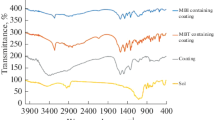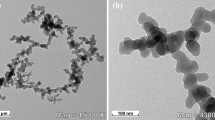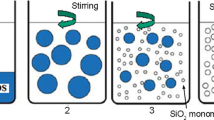Abstract
Pure and rosemary-extract-doped hybrid nanostructure coatings have been generated using sols synthesized via acid catalyzed hydrolysis and condensation of methacryloxypropyltrimethoxysilane (TMSM) and tetraethoxysilane (TEOS) at the molar ratio of 1: 1, in combination with rosemary extract. Coatings have been deposited on stainless steel (SS) 304L substrates by spin coating followed by curing at room temperature for 24 h in air and characterized. The morphology, composition and adhesion of hybrid sol-gel coatings have been examined by SEM, EDX and pull-off test, respectively. Addition of high additive concentrations (0.1%) did not disorganize the sol-gel network. Direct pull-off test recorded a mean coating-substrate bonding strength larger than 23.21 MPa for the hybrid sol-gel coating. Corrosion testing of coatings on SS 304L was studied by potentiodynamic polarization measurements and electrochemical impedance spectroscopy after 1 h and 21 days exposure to the physiological saline solution. The corrosion resistances of hybrid rosemary-extract-doped coatings after 1 h and 21 days exposure to the physiological saline solution were higher than that of pure hybrid silica coatings, both of which had thicknesses ranging lower than 100 nm. Also the electrochemical beha-viors of doped coating were studied by potentiodynamic polarizations tests in 3.5% NaCl media and the results were shown that this system is applicable in industry.
Similar content being viewed by others
References
Lee, S.M., Lee, B.S., Byun, T.G., and Song, K.C., Preparation and antibacterial activity of silver-doped organic-inorganic hybrid coatings on glass substrates, Colloid Surface A, 2010, vol. 355, pp. 161–165.
Mennig, M., Schmitt, M., and Schmidt, H., Synthesis of Ag-colloids in sol-gel derived SiO2-coatings on glass, J. Sol-Gel Sci. Techn., 1997, vol. 8, pp. 1035–1042.
Jeon, H.J., Yi, S.C., and Oh, S.G., Preparation and antibacterial effects of Ag-SiO2 thin films by sol-gel method, Biomaterials, 2003, vol. 24, pp. 4921–4928.
Marini, M., Niederhausern, D.D., Iseppi, R., Bondi, M., Sabia, C., Toselli, M., and Pilati, F., Antibacterial activity of plastics coated with silver-doped organic-inorganic hybrid coatings prepared by sol-gel processes, Biomacromolecules, 2007, vol. 8, pp. 1246–1254.
Subasri, R., Malathi, R., Jyothirmayi, A., and Hebalkar, N.Y., Synthesis and characterization of CuO-hybrid silica nanocomposite coatings on SS 304, Ceram. Int., 2012, vol. 38, pp. 5731–5740.
Lubick, N., Nanosilver toxicity: ions, nanoparticles or both, Environ. Sci. Technol., 2008, vol. 42, p. 8617.
Heidenau, F., Mittelmeier, W., Detsch, R., Haenle, M., Stenzel, F., Ziegler, G., and Gollwitzer, H., A novel antibacterial titania coating: metal ion toxicity and in vitro surface colonization, J. Mater. Sci.-Mater. M, 2005, vol. 16, pp. 883–888.
Pandian Bothi Raja and Mathur Gopalakrishnan Sethuraman, Natural products as corrosion inhibitor for metals in corrosive media. A review, Mater. Lett., 2008, vol. 62, pp. 113–116.
Amitha Rani, B.E. and Basu, B.B.J., Green inhibitors for corrosion protection of metals and alloys: An overview, Int. J. Corrosion, 2012, Article ID 380217, p. 15.
Kliškić, M., Radošević, J., Gudić, S., and Katalinić, V., Aqueous extract of Rosmarinus Officinalis L. as inhibitor of Al-Mg alloy corrosion in chloride solution, J. Applied Electrochem., 2000, vol. 30, no. 7, pp. 823–830.
El Ouariachi, E., Paolini, J., and Bouklah, M., Adsorption properties of Rosmarinus officinalis oil as green corrosion inhibitors on C38 steel in 0.5M H2SOom4, Acta Metall. Sin., 2010, vol. 23, pp. 13–20.
Del Campu, J. and Aniiol, M.J., Nguyen-The C. antimicrobial effect of rosemary extracts, J. Food Prot., 2000, vol. 63, no. 10, pp. 1359–1368.
Ozcan, M., Antioxidant activity of rosemary, sage and sumac extract and their combinations on stability of natural peanut oil, J. Med. Food, 2003, vol. 6, no. 3, pp. 267–270.
Luqman, S., Dwivedi, G.R., Darokar, M.R., Kaira, A., and Khanuja, S.P.S., Potential of rosemary oil to be used in drug-resistant infections, Alternative Therapiesin Health and Medicine, 2007, vol. 13, no. 5, pp. 54–59.
Tovar, L., Salafranca, J., Snchez, C., and Nern, C., Migration studies to assess the safety in use of a new antioxidant active packaging, J. Agric. Food Chem., 2005, vol. 53, no. 13, pp. 5270–5275.
Elsener, B., Rota, A., and Bohni, H., Impedance study on the corrosion of PVD and CVD titanium nitride coatings, Mater. Sci. Forum., 1989, vols. 44–45, pp. 28–38.
Mansfeld, F. and Kendig, M.W., Electrochemical impedance spectroscopy of protective coatings, Mater Corros., 1985, vol. 36, pp. 473–483.
Mansfield, F., Kendig, M.W., and Tsai, S., Evaluation of corrosion behavior of coated metals with AC impedance measurements, Corrosion, 1982, vol. 38, pp. 478–485.
López, D.A., Simison, S.N., and de Sánchez, S.R., The influence of steel microstructure on CO2 corrosion EIS studies on the inhibition efficiency of benzimidazole, Electrochim Acta, 2003, vol. 48, pp. 845–854.
Lorenz, W.J., Determination of corrosion rates by electrochemical DC and AC methods, Corros Sci., 1981, vol. 21, pp. 647–672.
Makino, T., Ono, T., Matsuyama, K., Nogaki, F., Miyawaki, S., Honda, G., and Muso, E., Inhibitory effects of rosmarinic acid on the proliferation of cultured murine mesangial cells, Nephrol Dial Transplant., 2000, vol. 15, p. 1140.
Harborne, J.B. and Williams, C.A., Advances in flavonoid research since 1992, Phytochem., 2000, vol. 55, pp. 481–504.
Kliskica, M., Radosevica, J., Gudica, S., and Katlinca, V., Aqueous extract of Rosmarinus Officinalis L. as inhibitor of Al-Mg alloy corrosion in chloride solution, J. Appl. Electrochem., 2000, vol. 30, pp. 823–830.
Author information
Authors and Affiliations
Corresponding author
Additional information
The article is published in the original.
About this article
Cite this article
Nasr-Esfahani, M., Pourriahi, M., Ashrafi, A. et al. Corrosion performance of rosemary-extract-doped TEOS:TMSM sol-gel coatings on 304L stainless steel. Surf. Engin. Appl.Electrochem. 50, 337–345 (2014). https://doi.org/10.3103/S1068375514040097
Received:
Published:
Issue Date:
DOI: https://doi.org/10.3103/S1068375514040097




